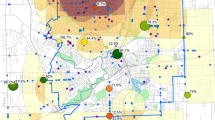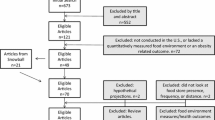Abstract
Measuring features of the local food environment has been a major challenge in studying the effect of the environment on diet. This study examined associations between alternate ways of characterizing the local food environment by comparing Geographic Information System (GIS)-derived densities of various types of stores to perception-based measures of the availability of healthy foods. Survey questions rating the availability of produce and low-fat products in neighborhoods were aggregated into a healthy food availability score for 5,774 residents of North Carolina, Maryland, and New York. Densities of supermarkets and smaller stores per square mile were computed for 1 mile around each respondent’s residence using kernel estimation. The number of different store types in the area was used to measure variety in the food environment. Linear regression was used to examine associations of store densities and variety with reported availability. Respondents living in areas with lower densities of supermarkets rated the selection and availability of produce and low-fat foods 17% lower than those in areas with the highest densities of supermarkets (95% CL, −18.8, −15.1). In areas without supermarkets, low densities of smaller stores and less store variety were associated with worse perceived availability of healthy foods only in North Carolina (8.8% lower availability, 95% CL, −13.8, −3.4 for lowest vs. highest small-store density; 10.5% lower 95% CL, −16.0, −4.7 for least vs. most store variety). In contrast, higher smaller store densities and more variety were associated with worse perceived healthy food availability in Maryland. Perception- and GIS-based characterizations of the environment are associated but are not identical. Combinations of different types of measures may yield more valid measures of the environment.
Similar content being viewed by others
References
Moore LV, Diez-Roux AV, Nettleton JA, Jacobs DR. Associations of the local food environment with diet quality-a comparison of GIS and survey assessments: the multi-ethnic study of atherosclerosis. Am J Epidemiol. 2008 (in press).
Diez-Roux AV, Nieto FJ, Caulfield L, Tyroler HA, Watson RL, Szklo M. Neighbourhood differences in diet: the Atherosclerosis Risk in Communities (ARIC) Study. J Epidemiol Community Health. 1999;53(1):55–63.
Laraia BA, Siega-Riz AM, Kaufman JS, Jones SJ. Proximity of supermarkets is positively associated with diet quality index for pregnancy. Prev Med. 2004;39(5):869–875.
Sloane DC, Diamant AL, Lewis LB, et al. Improving the nutritional resource environment for healthy living through community-based participatory research. J Gen Intern Med. 2003;18(7):568–575.
Morland K, Wing S, Diez Roux A. The contextual effect of the local food environment on residents’ diets: the atherosclerosis risk in communities study. Am J Public Health. 2002;92(11):1761–1767.
Cheadle A, Psaty BM, Curry S, et al. Community-level comparisons between the grocery store environment and individual dietary practices. Prev Med. 1991;20(2):250–261.
Zenk SN, Schulz AJ, Hollis-Neely T, et al. Fruit and vegetable intake in African Americans income and store characteristics. Am J Prev Med. 2005;29(1):1–9.
Brownson RC, Haire-Joshu D, Luke DA. Shaping the context of health: a review of environmental and policy approaches in the prevention of chronic diseases. Annu Rev Public Health. 2006;27:341–370.
Jeffery RW, Utter J. The changing environment and population obesity in the United States. Obes Res. 2003;11:12S–22S.
Matson-Koffman DM, Brownstein JN, Neiner JA, Greaney ML. A site-specific literature review of policy and environmental interventions that promote physical activity and nutrition for cardiovascular health: what works? Am J Health Promot. 2005;19(3):167–193.
Wrigley N, Warm D, Margetts B. Deprivation, diet, and food-retail access: findings from the Leeds ‘food deserts’ study. Environ Plan. 2003;35(1):151–188.
Moore LV, Roux AVD. Associations of neighborhood characteristics with the location and type of food stores. Am J Public Health. 2006;96(2):325–331.
Morland K, Wing S, Diez Roux A, Poole C. Neighborhood characteristics associated with the location of food stores and food service places. Am J Prev Med. 2002;22(1):23–29.
Morland K, Diez Roux AV, Wing S. Supermarkets, other food stores, and obesity: the atherosclerosis risk in communities study. Am J Prev Med. 2006;30(4):333–339.
Alwitt LA, Donley TD. Retail stores in poor urban neighborhoods. J Consum Aff. 1997;31(1):139.
Zenk SN, Schulz AJ, Israel BA, James SA, Bao S, Wilson ML. Neighborhood racial composition, neighborhood poverty, and the spatial accessibility of supermarkets in metropolitan Detroit. Am J Public Health. 2005;95(4):660–667.
Mujahid M, Diez Roux AV, Morenoff J, Raghunathan TE. Assessing the measurement properties of neighborhood scales: from psychometrics to ecometrics. Am J Epidemiol. 2007;168:858–867.
Raudenbush SW, Sampson RJ. Ecometrics: toward a science of assessing ecological settings, with application to the systematic social observation of neighborhoods. Sociol Method. 1999;29:1–41.
Horowitz CR, Colson KA, Hebert PL, Lancaster K. Barriers to buying healthy foods for people with diabetes: evidence of environmental disparities. Am J Public Health. 2004;94(9):1549–1554.
Giles-Corti B, Donovan RJ. Socioeconomic status differences in recreational physical activity levels and real and perceived access to a supportive physical environment. Prev Med. 2002;35(6):601–611.
Kirtland KA, Porter DE, Addy CL, et al. Environmental measures of physical activity supports: perception versus reality. Am J Prev Med. 2003;24(4):323–331.
Troped PJ, Saunders RP, Pate RR, Reininger B, Ureda JR, Thompson SJ. Associations between self-reported and objective physical environmental factors and use of a community rail-trail. Prev Med. 2001;32(2):191–200.
Troped PJ, Saunders RP, Pate RR, Reininger B, Addy CL. Correlates of recreational and transportation physical activity among adults in a New England community. Prev Med. 2003;37(4):304–310.
van Lenthe FJ, Brug J, Mackenbach JP. Neighbourhood inequalities in physical inactivity: the role of neighbourhood attractiveness, proximity to local facilities and safety in The Netherlands. Soc Sci Med. 2005;60(4):763–775.
Graham R, Kaufman L, Novoa Z, Karpa A. Eating in, eating out, eating well: access to healthy food in North and Central Brooklyn. Brooklyn district public health office. New York City Department of Health and Mental Hygiene; 2006 Jan 19.
Jetter KM, Cassady DL. The availability and cost of healthier food alternatives. Am J Prev Med. 2006;30(1):38–44.
Sloane D, Nascimento L, Flynn G, et al. Assessing resource environments to target prevention interventions in community chronic disease control. Journal of Health Care for the Poor and Underserved. 2006;17(2):146–158.
Zenk SN, Schulz AJ, Israel BA, James SA, Bao SM, Wilson ML. Fruit and vegetable access differs by community racial composition and socioeconomic position in Detroit, Michigan. Ethn Dis. 2006;16(1):275–280.
Auchincloss AH, Roux AVD, Brown DG, O'Meara ES, Raghunathan TE. Association of insulin resistance with distance to wealthy areas-the multi-ethnic study of atherosclerosis. Am J Epidemiol. 2007;165(4):389–397.
Chung C, Myers SL. Do the poor pay more for food? An analysis of grocery store availability and food price disparities. J Consum Aff. 1999;33(2):276.
Gatrell A, Bailey T, Diggle P, Rowlingson B. Spatial point pattern analysis and its application in geographical epidemiology. Trans Inst Br Geogr. 1996;NS 21:256–274.
Guagliardo MF. Spatial accessibility of primary care: concepts, methods and challenges. Int J Health Geogr. 2004;3(1):3.
Eisenhauer E. In poor health: supermarket redlining and urban nutrition. GeoJournal. 2001;53(2):125.
Pothukuchi K. Attracting supermarkets to inner-city neighborhoods: economic development outside the box. Econ Dev Q. 2005;19(3):232–244.
Krieger N, Waterman P, Lemieux K, Zierler S, Hogan JW. On the wrong side of the tracts? Evaluating the accuracy of geocoding in public health research. Am J Public Health. 2001;91(7):1114–1116.
Kravets N, Hadden WC. The accuracy of address coding and the effects of coding errors. Health Place. 2007;13(1):293–298.
Ong P, Graham M, Houston D. Policy and programmatic importance of spatial alignment of data sources. Am J Public Health. 2006;96(3):499–504.
Whitsel EA, Rose KM, Wood JL, Henley AC, Liao DP, Heiss G. Accuracy and repeatability of commercial geocoding. Am J Epidemiol. 2004;160(10):1023–1029.
Mujahid MS, Diez Roux AV, Morenoff JD, Raghunathan T. Assessing the measurement properties of neighborhood scales: from psychometrics to ecometrics. Am J Epidemiol. 2007;165(8):858–867.
Saelens BE, Glanz K, Sallis JF, Frank LD. Nutrition environment measures study in restaurants (NEMS-R) development and evaluation. Am J Prev Med. 2007;32(4):273–281.
Auchincloss AH, Diez Roux AV, Brown DG, Raghunathan TE, Erdmann CA. Filling the gaps: spatial interpolation of residential survey data in the estimation of neighborhood characteristics. Epidemiology. 2007;18(4):469–478.
Acknowledgements
This work was supported by grant R01 HL071759 (Dr. Ana V. Diez Roux) from the National Heart, Lung, and Blood Institute and by grant R24 HD047861 from the Columbia Center for the Health of Urban Minorities (Columbia University, New York, New York).
Author information
Authors and Affiliations
Corresponding author
Additional information
Moore and Diez Roux are with the University of Michigan, Department of Epidemiology, Ann Arbor, MI, USA; Brines is with the University of Michigan School of Natural Resources and Environment Dana Building, Ann Arbor, MI, USA.
Rights and permissions
About this article
Cite this article
Moore, L.V., Diez Roux, A.V. & Brines, S. Comparing Perception-Based and Geographic Information System (GIS)-Based Characterizations of the Local Food Environment. J Urban Health 85, 206–216 (2008). https://doi.org/10.1007/s11524-008-9259-x
Received:
Accepted:
Published:
Issue Date:
DOI: https://doi.org/10.1007/s11524-008-9259-x




